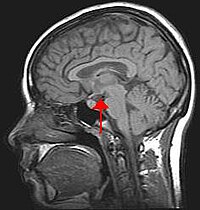
Photo from wikipedia
Numerous physiological processes in nature have multiple oscillations within 24 h, that is, ultradian rhythms. Compared to the circadian rhythm, which has a period of approximately one day, these short… Click to show full abstract
Numerous physiological processes in nature have multiple oscillations within 24 h, that is, ultradian rhythms. Compared to the circadian rhythm, which has a period of approximately one day, these short oscillations range from seconds to hours, and the mechanisms underlying ultradian rhythms remain largely unknown. This review aims to explore and emphasize the implications of ultradian rhythms and their underlying regulations. Reproduction and developmental processes show ultradian rhythms, and these physiological systems can be regulated by short biological rhythms. Specifically, we recently uncovered synchronized calcium oscillations in the organotypic culture of hypothalamic arcuate nucleus (ARN) kisspeptin neurons that regulate reproduction. Synchronized calcium oscillations were dependent on voltage-gated ion channel-mediated action potentials and were repressed by chemogenetic inhibition, suggesting that the network within the ARN and between the kisspeptin population mediates the oscillation. This minireview describes that ultradian rhythms are a general theme that underlies biological features, with special reference to calcium oscillations in the hypothalamic ARN from a developmental perspective. We expect that more attention to these oscillations might provide insight into physiological or developmental mechanisms, since many oscillatory features in nature still remain to be explored.
Journal Title: Molecules and Cells
Year Published: 2020
Link to full text (if available)
Share on Social Media: Sign Up to like & get
recommendations!